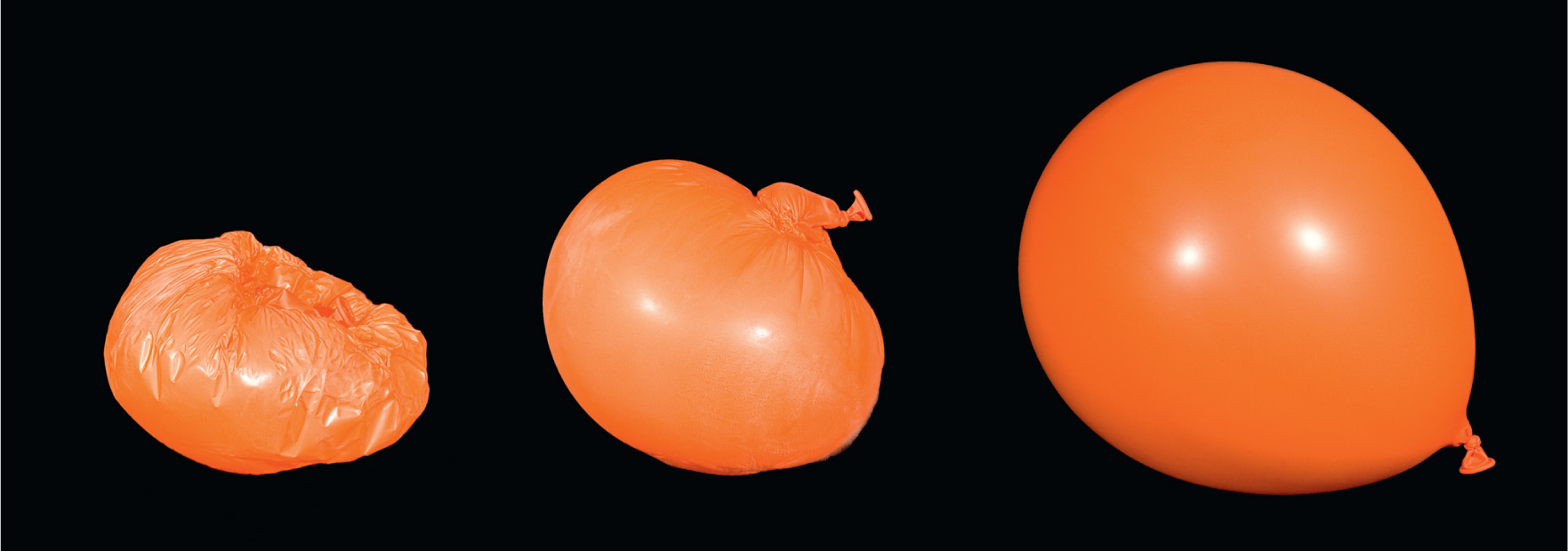The ‘discovery’ of atoms in the early years of the nineteenth century resulted from the accumulation of evidence from several different lines of experiment and observation, which were pulled together and formulated by the English scientist John Dalton. Dalton had a lifelong interest in meteorology, and his first steps towards an atomic theory came from the realization that the atmosphere consists of a mixture of gases, with different chemical properties, which do not settle out into different layers but are intermingled. In particular, of special interest to a meteorologist, when water evaporates to make a gas the vapour mingles with the air that already exists, occupying the same space at the same time. It does not push the air out of the way to make a separate layer of water vapour, above or below the air.
This suggested to Dalton that water vapour and air (and other gases) must be made up from separate particles with space between them. You might make an analogy with a box full of pebbles, which has spaces between the pebbles themselves, but no room for more pebbles. But a fine sand, itself made from separate particles, can be poured into the spaces between the pebbles, occupying the same box – that is, the same volume of space. Dalton’s experiments showed that the pressure exerted by a certain volume of gas at a certain temperature is always the same as the sum of the pressures that would be exerted by each gas in the mixture on its own. For example, if a container holds a litre of carbon dioxide at atmospheric pressure, and another container holds a litre of nitrogen at atmospheric pressure, if the two gases are squeezed into a single litre volume, the resulting pressure will be twice atmospheric pressure. This is known as Dalton’s law of partial pressures, which he spelled out in 1801.
At around the same time, Dalton discovered another law. Although this one does not bear his name, it demonstrates the idea of atoms even more clearly. By heating different gases and measuring their pressure, he found that ‘all elastic fluids under the same pressure expand equally by heat’. A quantitative way to measure this is to have a vertical cylinder in which some gas is trapped by a piston, with a weight on the piston applying a steady downward pressure. If the cylinder is heated, the gas expands, pushing the cylinder up even though the pressure is the same. But a simple qualitative demonstration of the same effect can be observed using a child’s balloon. If the balloon is inflated to its maximum size at room temperature, its skin will be as tight as that of the proverbial drum. But if the balloon is now cooled with ice water, the pressure of the gas inside will go down, and the skin of the balloon will become flabby and wrinkly. In effect, the gas has shrunk. Let the balloon warm up again, and the skin again becomes tight. An even more dramatic demonstration of the effect can be observed by cooling the balloon with liquid nitrogen. The same gas at the same pressure occupies a greater volume at higher temperatures.

© David Taylor/Science Photo Library
Balloon expanding as it warms. The balloon on the left has been cooled to –198 ºC using liquid nitrogen. The molecules of air in this balloon have less energy when cooled and move slower, producing less pressure on the inside of the balloon, so it has collapsed to a smaller size. The balloon on the right has been allowed to warm up to room temperature and has regained its normal air volume. In this case the air molecules have more energy and move faster, therefore exerting more pressure on the inside of the balloon, making it expand to a larger size.
The same thing was noticed by the Frenchman Joseph Gay-Lussac about a year later, but he discovered that it had previously been observed by his compatriot, Jacques Charles, in 1787. The news had not spread, because Charles did not publish his discovery. But Gay-Lussac promoted it under the name ‘Charles’s Law’ (see here). The obvious explanation is that gases are indeed made of atoms, and that they are somehow pushed further apart from one another at higher temperatures.

© Science Photo Library
John Dalton’s (1766–1844) table of atomic symbols. Although he had the right idea about atomic theory and chemical reactions, some of his identifications of elements and compounds are now known to be wrong. Lime, for example, is a compound of calcium, and water is not HO.
All of this led Dalton to develop the idea that different gases are made of different kinds of atoms, with different sizes, different weights. This led him to carry out chemical experiments comparing the quantity of different elements involved in various reactions. Among other things, by studying the gases now known as ethylene (olefiant gas) and methane (carburetted hydrogen), he found that although both are made only of carbon and hydrogen, methane had exactly twice as much hydrogen in relation to carbon as ethylene. Such studies led him to a fuller exposition of the atomic theory, published in 1808, which can be summed up as:
Substances are composed of indivisible particles called atoms.
Each element consists of a characteristic kind of identical atom. Thus there are as many kinds of atoms as elements. Atoms of a particular element are perfectly alike.
Atoms are unchangeable.
When elements combine to form a compound, the smallest portion of the compound is a group containing a definite number of atoms of each element.
In chemical reactions, atoms are never created nor destroyed, but only rearranged.
This remains the basis of our modern understanding of the structure of matter, except that atoms are no longer thought to be indivisible (see here).

